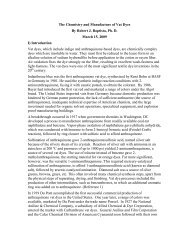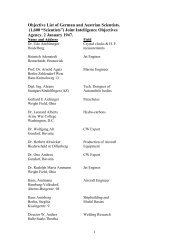International Dyestuff Industry - ColorantsHistory.Org
International Dyestuff Industry - ColorantsHistory.Org
International Dyestuff Industry - ColorantsHistory.Org
You also want an ePaper? Increase the reach of your titles
YUMPU automatically turns print PDFs into web optimized ePapers that Google loves.
of the group expanded production of intermediates considerably. Montedison signed a five<br />
year contract with the Polish Chemical Authority in 1981 for exchange of products; Poland<br />
would supply intermediates for dyestuffs.<br />
There were several upheavals in France, characterized by not always successful mergers<br />
and diversification. Over half the French chemical industry fell into state control and there<br />
was considerable reorganization in 1982-83 and during the early 1990s. Kuhlmann became<br />
part of the Pechiney-Ugine-Kuhlmann group in 1972 and dyestuffs and other chemicals<br />
were generally run down or sold off. By 1989 some 40 per cent of the private sector was in<br />
the hands of foreign-owned companies.<br />
There were also upheavals in Britain. In 1981, the British Economic Development<br />
Committee for the Chemical <strong>Industry</strong> predicted the decline of production in Western Europe<br />
(mainly Britain, Germany, and Switzerland) due to the emergence of manufacturers in<br />
Eastern Europe and the Far East. This led to considerable reorganization. Thus the former<br />
Yorkshire Dyeware & Chemical Co., known as Yorkshire Chemicals Limited from 1971 (by<br />
which time natural dye preparations had been replaced by the manufacture of synthetics),<br />
was particularly vigorous in promotion of its products. New outlets were established in<br />
Europe (especially Italy), the Far East, and in the United States as Yorkshire Pat-Chem, Inc.<br />
Today the color division of Yorkshire Chemicals plc is based in Leeds, while specialty<br />
products are manufactured at Selby, North Yorkshire<br />
L.B. Holliday was less fortunate. Although the firm had received the Queen's award for<br />
exports in 1978, the recession during the following years led to receivership in 1981. A.T.<br />
Bray bought out the assets in 1982 and set up Holliday Dyes & Chemicals Ltd., in 1992 a<br />
thriving enterprise. This company is currently expanding its efforts in the United States and<br />
in other foreign markets<br />
ICI's response was to "strengthen its position as a world supplier of dyes, pigments and<br />
auxiliaries through the proposed acquisition of the French chemicals company<br />
PCUK-Produits Chimiques Ugine Kuhlmann." [66] The acquisition of PCUK , whose dyes<br />
were sold under the Francolor trademark, took place late in 1982, and included<br />
manufacturing units at Oissel (south of Rouen specializing in azo dyes and pigments). Saint<br />
Clair du Rhone (midway between Lyon and Grenoble; azo leather and triphenylmethane<br />
dyes), and Villers Saint Paul (north of Paris; phthalocyanine blues and Solanthrene vat<br />
dyes).<br />
The PCUK subsidiary Societe des Produits Chimiques et des Matieres Colorantes de<br />
Mulhouse was also taken over by ICI, as were the British subsidiaries Alliance Dye &<br />
Chemical Co., and Catco Chemicals of Bolton, Lancashire, and the Fosfanil factory in Brazil.<br />
This increased ICI's color sales by 50 percent, with an annual turnover exceeding £250m.<br />
The conditions of sale had been agreed on 1 October 1982, and early in the following year<br />
ICI Francolor SA was created, a wholly owned subsidiary of ICI incorporating its former<br />
sales agency, ICI France. [67] ICI had thus inherited not only the interests of the<br />
successors to Perkin, Simpson, Maule & Nicholson, Levinstein, the Hollidays, and Morton,<br />
but also the innovative tradition established by Poirrier at Saint Denis, Paris, where in the<br />
1860s the new alkylation of aniline process was first conducted. Not far away, at Villers<br />
Saint Paul dye making was fully computerized in 1982, while at Oissel, "red and yellow azo<br />
dyes are synthesized by a continuous process. This is believed to be the first and only one<br />
of its kind in the world."<br />
Many factors would contribute to changes in the United States dye industry. The boom<br />
years were the 1950s and 60s. In March 1950, seventy percent of Arnold Hoffman & Co.,<br />
Inc. of Providence, Rhode Island, and Dighton, Mass. was purchased by Britain's ICI.<br />
Soledon and Caledon dyes were made at Dighton, and there were additional facilities at<br />
Charlotte, North Carolina. The takeover by ICI was soon complete, and the title ICI<br />
<strong>Org</strong>anics was adopted in July 1963 (ICI America, Inc., from October 1958). This was the<br />
formative period of the present ICI Americas. In 1954, the Althouse Chemical Company, of<br />
Reading, Pennsylvania, was purchased by Crompton & Knowles, a long established firm of<br />
textile machinery manufacturers. They opened a Belgian subsidiary, Althouse Tertre SA,<br />
1969. A completely new dye-maker, Fabricolor, was founded in 1961, with a works at<br />
Paterson, New Jersey.





